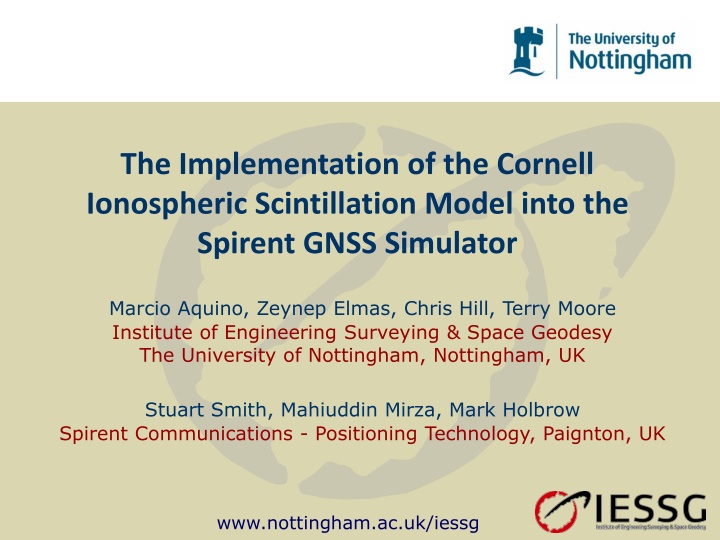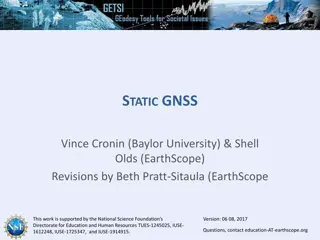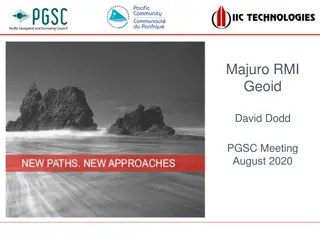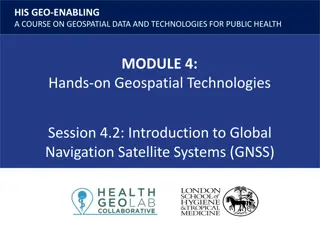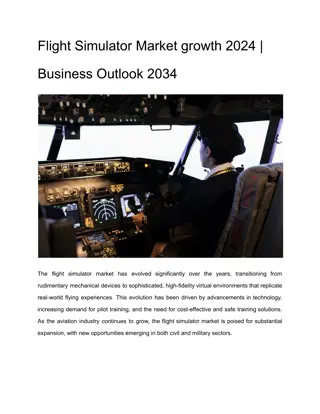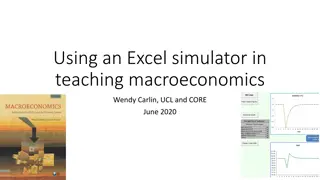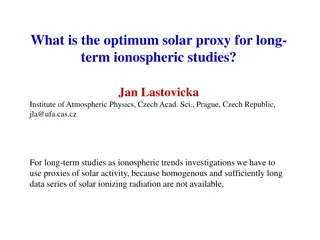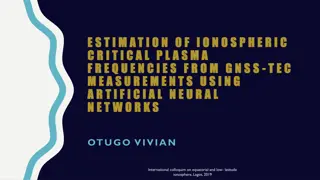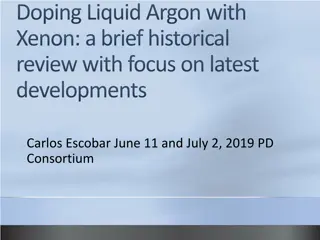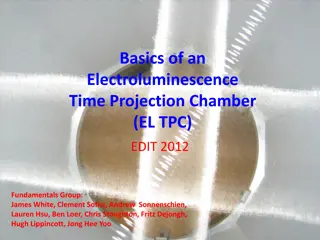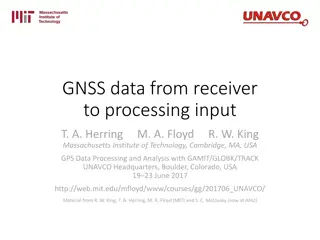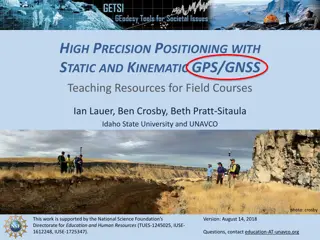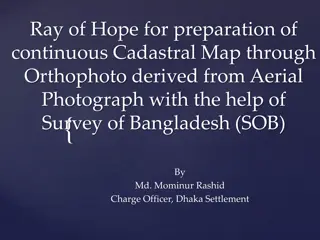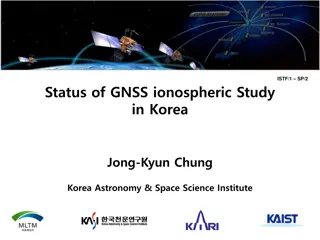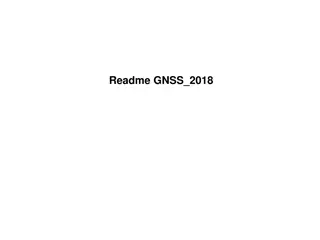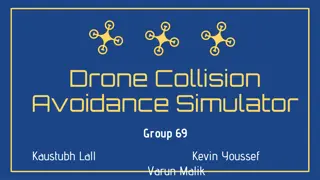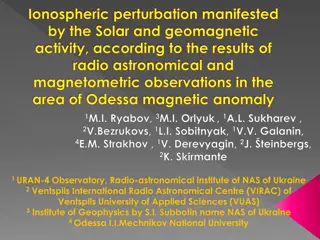Implementation of Cornell Ionospheric Scintillation Model in Spirent GNSS Simulator
Researchers from the University of Nottingham and Spirent Communications collaborated to implement the Cornell Ionospheric Scintillation Model into the Spirent GNSS Simulator. The study focuses on the diffractive effects of ionospheric scintillation on GNSS signals, examining small-scale plasma irregularities and variations in signal phase and amplitude. It also explores the impact of ionospheric scintillation on GNSS receivers, including degradation in tracking loop performance and the effects on code and phase alignment. Additionally, a suggested Signal Tracking Loop Error model by Conker et al. is discussed, highlighting advantages and drawbacks for modeling weak to moderate scintillation levels.
Download Presentation

Please find below an Image/Link to download the presentation.
The content on the website is provided AS IS for your information and personal use only. It may not be sold, licensed, or shared on other websites without obtaining consent from the author.If you encounter any issues during the download, it is possible that the publisher has removed the file from their server.
You are allowed to download the files provided on this website for personal or commercial use, subject to the condition that they are used lawfully. All files are the property of their respective owners.
The content on the website is provided AS IS for your information and personal use only. It may not be sold, licensed, or shared on other websites without obtaining consent from the author.
E N D
Presentation Transcript
The Implementation of the Cornell Ionospheric Scintillation Model into the Spirent GNSS Simulator Marcio Aquino, Zeynep Elmas, Chris Hill, Terry Moore Institute of Engineering Surveying & Space Geodesy The University of Nottingham, Nottingham, UK Stuart Smith, Mahiuddin Mirza, Mark Holbrow Spirent Communications - Positioning Technology, Paignton, UK www.nottingham.ac.uk/iessg
Ionospheric Diffractive Effects on GNSS signals Small scale plasma / electron density irregularities Fluctuations in the phase and amplitude of the received signal Ionospheric Scintillation Scintillation indices and S4 : sd of the measured phase S4 : sd of the received signal power normalized by the average signal power
Ionospheric Scintillation Effects on GNSS receivers Geographic and temporal variation in scintillation occurrence Code and phase tracking loop performance can be degraded DLL PLL Rapid intensity fluctuations Rapid phase fluctuations Affects accurate code phase alignment Affects accurate phase estimation Cycle slips, loss of lock, difficulty in tracking Difficulty in acquisition Variance of the error at DLL / PLL output (tracking jitter) increases during scintillation Good measure of the effect of scintillation on a receiver
Variance of the Signal Tracking Loop Error Model suggested by Conker et al (2003) p (spectral slope) T (spectral strength of phase noise at 1 Hz) 0 phase PSD linear fit Advantages Available, easy to implement Applicable to new signals Drawbacks Limited to weak-moderate scintillation levels Spectral parameters p and T are needed Phase & amplitude scintillation modelled as independent y = - 1.4*x - 4 (p=1.4) -1 p=1.4 -2 -3 log spectral power -4 -5 -6 T -7 -8 -9 -2 -1.5 -1 -0.5 0 0.5 1 1.5 log frequency
Cornell Scintillation Model Equatorial scintillation model Based on statistical properties of scintillation effects start Receiver to be tested
Cornell Scintillation Model CSM can be used for testing GPS receiver phase tracking loops performance under equatorial scintillation: Deep fading requires signal amplitude and phase spectra to be shaped as dependent on each other. Two important assumptions in CSM: 1) Amplitude of GNSS signal due to scintillation environment follows Rice distribution 2) Scintillation component of GNSS signal has a spectrum similar to that of white noise passing through a 2nd order low pass Butterworth filter.
Cornell Scintillation Model CSM requires two inputs to define the severity of the scintillation : S4 : stdev of received signal power normalized by average signal power 0 : is the decorrelation time parameter such that at time 0 the autocorrelation function reduces to 1/eth of its initial value e.g. high S4 and low 0 represent severe scintillation
Implementation of the CSM Scintillation time histories written in correct file format Scintillation data recorded Track the perturbed signals with a scintillation specific receiver Scintillation file selected in the simulation scenario
Implementation of the CSM in the Spirent GNSS Simulator Spirent GSS8000 GNSS Simulator changes signal level (dB) and carrier phase range offsets (m) of the generated signals according to the User Commands File with input provided by the CSM Carrier phase range offsets (m) Signal level changes (dB)
Illustration of CSM GNSS Scintillation Simulation
CSM Performance Three 10-minute scintillation intervals 1 0.7 0.9 0.6 0.8 0.5 0.7 Sigma Phi (rad) 0.6 S4 0.4 0.5 S4 0.3 0.4 0.3 0.2 0.2 0.1 0.1 0 0 0 10 20 30 40 50 60 70 80 0 10 20 30 40 50 60 70 80 Scintillation indices S4 and recorded by the GSV4004B receiver are plotted (red bars show interval averages) Time (min) Time (min)
Receiver Performance Based on scintillation indices S4 and output by GSV4004 Rx, signal tracking performance can be evaluated from the variance of PLL error (Conker model, Strangeways Ff) 0.028 10-20 min, S4=0.49, SigPhi=0.29 rad 30-40 min, S4=0.48, SigPhi=0.29 rad 50-60 min, S4=0.28, SigPhi=0.17 rad 0.026 0.024 0.022 Variance of PLL error (rad 2) 0.02 0.018 0.016 0.014 0.012 0.01 0.15 0.2 0.25 0.3 Fresnel frequency (Hz)
CSM Performance 1 0.9 Six 15-minute scintillation intervals 1 0.8 0.7 0.9 0.7 0.6 0.8 0.6 0.5 0.7 0.5 S4 S4 0.4 0.6 0.4 0.3 0.5 0.3 S4 0.2 0.4 0.2 Recorded by receiver S4=0.59 S4=0.58 S4=0.41 S4=0.39 S4=0.67 S4=0.28 Recorded by receiver 0.3 0.1 =0.15r =0.2 r 0.1 0.2 0 0 1 16 31 46 61 76 91 106 120 1 16 31 46 61 76 91 106 120 Recorded by receiver Time (min) S4=0.59 S4=0.58 S4=0.41 S4=0.39 S4=0.67 S4=0.28 Time (min) Scintillation indices S4 and recorded by the GSV4004B receiver are plotted (red bars show interval averages). 0.1 0 1 16 31 46 61 76 91 106 120 Time (min)
Receiver Performance When could not be recorded (due to loss of lock) calculation of error variance for receiver phase tracking loop using the Conker model was not possible 0.16 S4=0.41, Tau0=0.2r S4=0.39, Tau0=0.2r S4=0.28, Tau0=0.15r 0.14 0.12 Variance of tracking loop (rad 2) 0.1 0.08 0.06 0.04 Only possible to calculate the PLL error variance for 3rd, 4th and 6th scintillation intervals 0.02 0 0.15 0.2 Fresnel Frequency (Hz) 0.25 0.3
GNSS Vulnerability During ionospheric scintillation, availability, reliability and accuracy of GNSS can be affected; Signal acquisition can be hindered, Code and carrier tracking can be difficult, Observations can degrade in accuracy. It is of paramount importance to test GNSS receivers against degrading effects of ionospheric scintillation prior to the peak of the solar cycle CSM in combination with the Spirent simulator offers a potentially reliable method of testing GNSS vulnerability and receiver performance under certain limitations/conditions.
Limitations of CSM CSM is based on equatorial scintillation effects. CSM is not a global scintillation model. In its current version, CSM is not amulti- frequency scintillation model. CSM is not applicable for testing multi-frequency GNSS receivers against equatorial scintillation. Ionospheric scintillation is typically associated with localized irregularity patches. Effects of these patches may disagree with the statistics observed in the case of homogeneous irregularities as implemented by CSM.
Conclusions CSM was able to reproduce simulated scintillation levels as verified by a specialised GPS scintillation monitor receiver As a measure of the effect of scintillation on receiver performance so far we have only assessed its influence on the PLL tracking error variance estimated from the models of Conker et al. It was seen that CSM can be used in combination with these tracking models for the purpose of testing receiver robustness during scintillation
Future Work Through availability of real equatorial scintillation data, scintillation parameters can be obtained to create scintillation time histories with CSM Such scintillation effects can be implemented in a GNSS signal simulator such as Spirent GNSS signal simulator to lab-test a GNSS receiver s signal tracking performance Different PLL models can be tested (e.g. different loop order, bandwidth) Insights into expected receiver performance for different scintillation levels. Implementing scintillation effects for all receiver-satellite links to assess implication on positioning and navigation.
Professor Terry Moore Director of IESSG The University of Nottingham Innovation Park, Triumph Road Nottingham NG7 2TU UK Telephone: Fax: Email: WWW: +44 (0) 115 951 3886 +44 (0) 115 951 3881 terry.moore@nottingham.ac.uk www.nottingham.ac.uk/iessg
